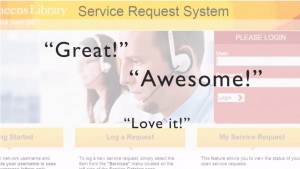What’s New at Kinetic: Building Smart in 2026
At Kinetic, we believe the future of Business Process Management isn’t bigger—it’s smarter.
Simplifying request management for employee services increases satisfaction and reduces costs in any type of organization—business enterprises, service providers, government agencies, non-profits,...

Simplifying request management for employee services increases satisfaction and reduces costs in any type of organization—business enterprises, service providers, government agencies, non-profits, and entities such as museums and libraries, which typically rely on a combination of public and private funding.
 Queens Library in New York is one of the largest circulating libraries in the United States, with about 1,000 full-time employees spread across 62 locations, serving 2.3 million customers each year. Nearly 11.2 million people walk through the doors, and library staff answers nearly 4.4 million reference inquiries every year.
Queens Library in New York is one of the largest circulating libraries in the United States, with about 1,000 full-time employees spread across 62 locations, serving 2.3 million customers each year. Nearly 11.2 million people walk through the doors, and library staff answers nearly 4.4 million reference inquiries every year.
Providing services to dispersed employees in a high-volume environment can involve significant challenges. Here’s the story of how Queens Library overcame its service management issues and delivered a happy ending to employees while reducing costs in the process.
A few years ago, the library was facing big challenges in delivering IT services. Queens Library’s IT group managed service requests using email and paper forms submitted through interoffice mail or in person. Employee frustrations were growing as requests were lost or took days to complete.
To reduce the strain on its IT service desk and improve service delivery, the library selected a self-service online request system. But the IT group quickly discovered it was not user friendly and would require extensive, costly customization.
In the search for alternatives, one of the library’s vendors recommended looking into enterprise request management (ERM) software from Kinetic Data. The IT group knew as soon as they saw Kinetic Request and Kinetic Task that these were the tools they needed.
The complete implementation—configuration, catalog building, branding and integration with the library’s IT service management platform—was ready for a soft launch within two months.
Employees were given no training, only instructed to provide feedback on their experience using the software. “Almost immediately, we received extremely positive responses. People loved the idea, thought the interface was very easy to use and were finally able to track information about their work orders,” said Devi Seerattan, the library’s service request systems manager.
The measurable results were impressive, too:
Not only is the ERM portal a huge win for the IT group, but after seeing it in action, managers from other departments started asking: “How can I get that?”
The facilities/maintenance group was next to embrace ERM, replacing the difficult and user-unfriendly work order process in the library’s ERP system. Within five months, all of their requests were migrated to Kinetic Request and Kinetic Task.
The time required to submit a request was slashed by 60%, while submission accuracy improved to 98% and fulfillment time was reduced 40%.
Queens Library also now uses its Kinetic Data software to manage logistics and security service requests, and plans to move all internal service groups—including HR—to Kinetic Data’s ERM platform.

At Kinetic, we believe the future of Business Process Management isn’t bigger—it’s smarter.

IT support automation uses software workflows, rule engines, AI/ML, and integrations to automate...

Business process reimagined is the strategic renewal of how work gets done by combining modern digital...